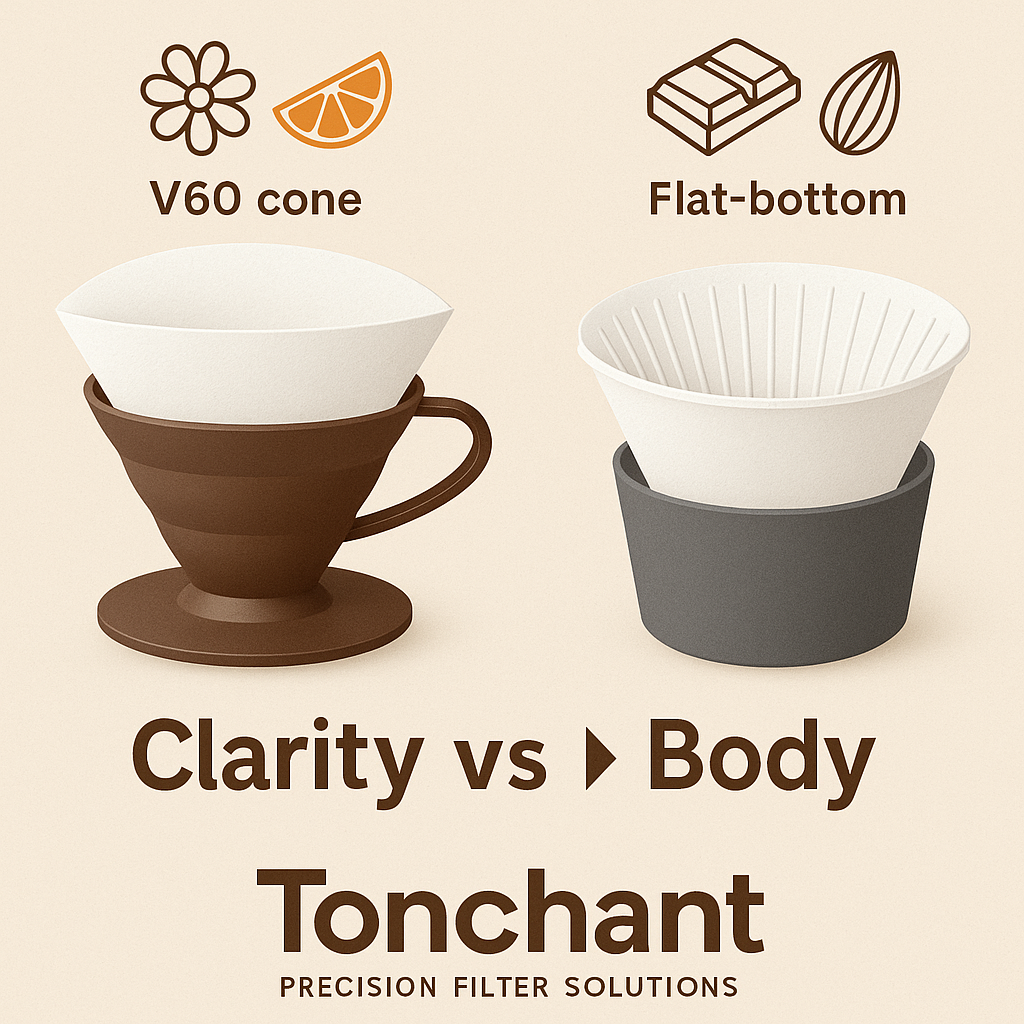For baristas and home brewers, the choice between a V60 conical filter and a flat-bottom (basket) filter influences how coffee is extracted and, generally, its taste. Both are essential filters for specialty coffee, but they perform differently due to geometry, fluid dynamics, and how the coffee grounds bed is formed. Tonchant, a manufacturer of precision filters and custom filter solutions, has thoroughly analyzed these differences so roasters and cafés can choose the filter paper and filter shape that best meets their roasting and brewing goals.
Filter geometry and its effect on flow
The V60 cone filter (the tall, angled cone popularized by Hario) concentrates the grounds into a deep, narrow filter. The cone’s slanted walls facilitate a spiral pour and create a single, focused flow path. This geometry generally results in:
1.The water flow in the center is fast and turbulent
2.Contact time is short unless the winemaker pauses or pulse pours
3.When dialed in, it provides greater clarity and can highlight bright floral or fruity notes
A flat-bottom or basket filter (used in many drip coffee machines and brewing methods) creates a shallower, wider filter. This allows the water to be more evenly distributed over the coffee grounds and drain through a larger cross-sectional area. Typical effects include:
1.Slower, more stable flow and longer contact time
2.Fuller-bodied wine with a rounder taste
3.Better performance for high-dose and batch brewing, where volume consistency is important
Extraction behavior and flavor differences
Because conical and basket filters alter fluid dynamics, affecting extraction balance, conical filters typically emphasize acidity and clarity: they require meticulous pour-over technique and finer grind adjustment. If you’re looking to highlight the delicate floral notes of Ethiopian or light roasted coffees, the V60 conical filter, paired with a medium-fine grind and precise pour-over, can better reveal these aromas.
Flat-bottomed drippers generally produce a richer, more balanced coffee flavor. The wider drip bed allows water to reach more grounds more evenly, making it ideal for medium roasts, blends, or darker beans that require a fuller extraction. Cafés that brew in batches or use drip machines often prefer basket drippers for their predictable brew size and flavor.
Paper and pore structure are equally important
Shape is only half the story. The paper’s basis weight, fiber blend, and air permeability determine the performance of your filter paper, regardless of its shape. Tonchant designs filter paper in a variety of geometries—lighter, more airy papers for fast, tapered brews, and heavier, more tightly pore papers for flat-bottom basket filters that need to slow water flow and trap fines. Choosing the right paper grade ensures your chosen filter paper shape produces the desired coffee flavor, rather than unexpected sourness or bitterness.
Practical Tips for Dial-In Each Filter Type
1.V60 Cone: Start with a medium-fine grind, use a pulse pour to maintain an even bed, and try a 16:1–15:1 water-to-coffee ratio for a total brew time of 2.5–3.5 minutes.
2.Flat-bottom basket: Use a slightly coarser grind than the cone, aim for a steady, continuous pour, and expect a brew time in the 3-5 minute range depending on the dose and filter weight.
3.If your cone brews fast and thin: Try a heavier paper grade or a finer grind.
4.If your coffee basket brews slowly and over-extracts: try using lighter paper or a coarser grind.
Operational considerations for cafes and bakeries
1.Throughput: Flat-bottom setups are generally better suited for batch serving and machines; cones excel in manual, show-style brewing that highlights single origins.
2.Training: The conical brewing method requires precise technique; the flat-bottom method is more accessible to employees of varying skill levels.
3.Branding and Packaging: Tonchant offers cone and basket filters in bleached and unbleached grades, along with private label sleeves and retail boxes to match the brand positioning.
When to choose one over the other
1.Choose the V60 Conical Filter when you want to showcase the clarity of single-origin coffees, perform barista-led hand brewing, or offer tasting flights.
2.Choose a flat-bottom basket strainer when you need high-volume consistency, want a fuller taste in your mix, or operate automatic drip systems in cafes and offices.
The role of tonchant in paper-to-shape matching
At Tonchant, we design our filters with the end brewer in mind. Our R&D and QA teams test various filter shapes, including cones and baskets, to adjust the basis weight and porosity for a predictable flow rate. We offer sample packs so roasters can conduct side-by-side cupping tests to see how the same coffee performs across different shapes and filters, helping customers choose the ideal combination for their menu.
Final Thoughts
V60 filters and flat-bottom filter baskets are more complementary tools than competitors. They each offer advantages suited to specific coffee beans, brewing styles, and business models. True excellence lies in pairing the right filter grade with the right shape and testing them on your equipment and recipes. If you need comparative samples, private label options, or technical guidance on brewing protocols, Tonchant can help you prototype and tailor a filter solution to your brand and coffee taste.
Post time: Sep-25-2025
